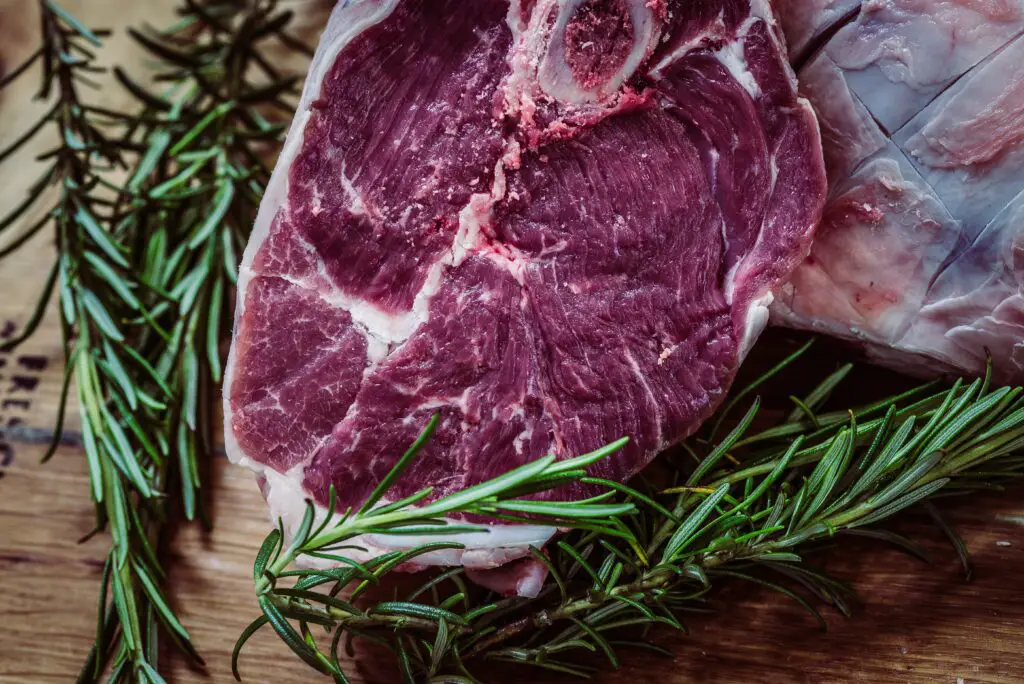Connective tissues give structure and support to the animal, which is why they tend to be very strong. When buying steaks, it’s important to know those with the most connective tissues to decide if they will be great for your cooking needs or if you should avoid them. Let’s discuss which ones have the most connective tissues and how we can tenderize their texture. Let us know ‘What Steaks Have The Most Connective Tissue?’.

The steaks with the most connective tissue are those cut from the cow’s entire shoulder area, which is the chuck cut.
What are connective tissues in steaks?
Connective tissues protect and give support and structure to the cow. They are proteinous fibrous cells that link muscle fibers together to form groups and connect these muscle groups to bones. Steaks have different types of connective tissue, but the two most prevalent connective tissues are elastin and collagen.
Elastin and collagen surround muscle tissues, but elastin is much heavier and can be seen with the eyes, while collagen cannot. Elastin creates a covering called the silverskin and ligament of muscle groups. No matter how you cook meats with this silverskin membrane (elastin), they will still be chewy; the best thing is to cut off most of the elastin from the steak before you cook.
Collagen is barely visible to the naked eye because it wraps elongated muscle fibers in a sheath, and the fibers are grouped to form groups of muscle tissues and wrapped again in a sheath of collagen. These groups of muscle tissues bundled together are what we call the ‘meat grain’.
What are the types of steaks with the most connective tissues?
As we mentioned earlier, steaks with the most connective tissues are chewy and rubbery because they contain high amounts of collagen or elastin. You may have been served such in a restaurant or even cooked it yourself without knowing which parts they are and how to avoid buying such again. So, here is what you need to know.
Chuck cuts
This refers to every part of the cow’s shoulder that connects to the leg. The connective tissue in this part provides enough support for the cows’ legs to walk; hence why it has to be tough. The chuck steak from veal may be a little tender than that of a mature cow or bull, and the steak’s hardness increases with the age of the animal. So, even though chuck steaks are flavorful and highly nutritious, cooking them seems to be a hassle because it takes longer, and if not done right under the right temperature, the result will still come out hard.
Tri-tip
Also called a sirloin steak, a Tri-tip is cut from the bottom region between the loin and back legs of the cow. Such a part needs to be tough because it holds so much weight for the cow. Irrespective of its toughness, it is flavorful when marinated first for hours and cooked medium-rare.
Round cuts
The round cuts come from the hind legs of cows, which get the most exercise, making them tougher than most cuts. Like the tri-tip steaks, they are packed with flavor, which is delicious when the steak is marinated for some time and cooked slowly by roasting to make it tender.
London broil
Like the round cut, London broil is from the cow’s back and has tough muscle fibers. The best way to prepare this steak is to cut against the fiber grain, marinate with an acidic ingredient like lemon, and cook to medium-rare on top of a grill or in a hot pan.
Flank cuts
You will know a flank steak by its thin and flat look but don’t let the thinness make you think it is tender. The flank steak is cut from the back side of a cow’s abdominal muscles and is best-prepared medium-rare by pan-frying, but first, you should marinate it for some hours to get the best flavor and nutrition from it.
What is the best way to break down connective tissues in steak?
Connective tissues hold the meat together, but once broken down, your steak will become tender and less chewy. The best ways to break down connective tissues in steaks are;
Marinade with an acidic ingredient
Some people think the reason for marinating steaks is to allow the ingredients absorb into the meat to improve the flavor. Well, that’s only one reason. When you marinate meat with cider vinegar, cooking wine, lime or lemon juice, etc., the acid breaks down the connective tissues, makes it tender, and enhances the flavor and edibleness.
Tenderize with a mallet before cooking
A mallet or meat tenderizer looks like a harmer but has blunted spikes. Pounding the steak with this tool will break down the connective tissues and make the steak softer. Place the meat on a flat surface and cover it with a plastic bag before you pound it.
Cook under low temperature for a long time
Using moist heat under low temperatures over a long time will break the collagen and tenderize the meat. What the heat does is that it breaks the connective tissue and transforms it into gelatin, which moistens the meat fibers, making it tender and flavorful.
Conclusion:
Steaks are nutritious and packed with flavors that can only be savored and enjoyed when we can chew them easily. Connective tissues, which hold meat fibers in place, tend to make the steaks cut from certain parts of a cow tough. It is now left to you to know these parts and use one or all of the tenderizing methods we discussed above to soften their texture and prepare a delicious meal.
FAQs
How long should I marinate steaks with the most connective tissues?
Marinate tough steaks for 12 to 24 hours for the best results.
What steaks have the least connective tissues?
The steaks with the least connective tissues include porterhouse, T-bone, tenderloin, and top loin steaks.

